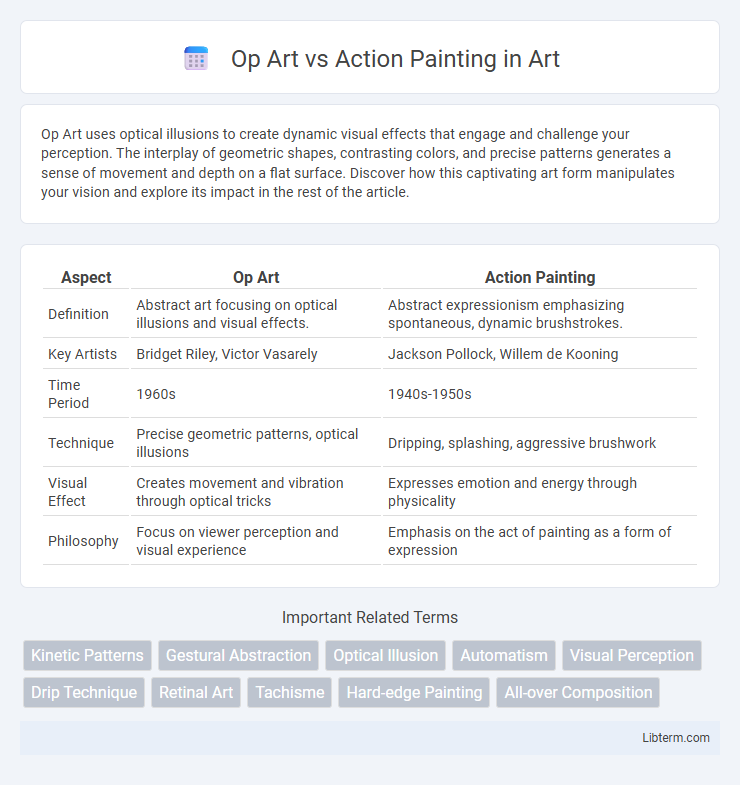Op Art uses optical illusions to create dynamic visual effects that engage and challenge your perception. The interplay of geometric shapes, contrasting colors, and precise patterns generates a sense of movement and depth on a flat surface. Discover how this captivating art form manipulates your vision and explore its impact in the rest of the article.
Table of Comparison
| Aspect | Op Art | Action Painting |
|---|---|---|
| Definition | Abstract art focusing on optical illusions and visual effects. | Abstract expressionism emphasizing spontaneous, dynamic brushstrokes. |
| Key Artists | Bridget Riley, Victor Vasarely | Jackson Pollock, Willem de Kooning |
| Time Period | 1960s | 1940s-1950s |
| Technique | Precise geometric patterns, optical illusions | Dripping, splashing, aggressive brushwork |
| Visual Effect | Creates movement and vibration through optical tricks | Expresses emotion and energy through physicality |
| Philosophy | Focus on viewer perception and visual experience | Emphasis on the act of painting as a form of expression |
Introduction to Op Art and Action Painting
Op Art, short for Optical Art, emphasizes visual effects and illusions through precise geometric patterns and contrasting colors that create a sense of movement or vibration. Action Painting, a style within Abstract Expressionism, focuses on spontaneous, energetic brushstrokes and the physical act of painting as an essential component of the artwork. Both movements revolutionized mid-20th-century art by challenging traditional techniques but differ significantly in method and viewer experience.
Historical Background and Origins
Op Art emerged in the 1960s, rooted in the study of optical illusions and visual perception influenced by artists like Bridget Riley and Victor Vasarely. Action Painting, dating back to the late 1940s and early 1950s, originated within Abstract Expressionism, with pioneers such as Jackson Pollock emphasizing spontaneous, physical brushwork. Both movements reflect distinct post-war artistic responses: Op Art exploring precise, mechanized effects of vision, while Action Painting prioritized dynamic, emotional gestures.
Key Artists and Influencers
Op Art, characterized by artists like Bridget Riley and Victor Vasarely, emphasizes optical illusions and precise geometric patterns to create visual movement. Action Painting, led by figures such as Jackson Pollock and Willem de Kooning, focuses on spontaneous, energetic brushstrokes and dynamic gestures to convey emotion and physical engagement. Both movements significantly influenced modern art, with Op Art centered on visual perception and Action Painting highlighting expressive processes.
Defining Characteristics of Op Art
Op Art emphasizes precise geometric patterns, optical illusions, and vibrant color contrasts to create visual movement and depth on a flat surface. It relies heavily on mathematical precision and repetition to engage the viewer's perception, often producing effects such as vibration, flickering, or warping. Unlike Action Painting, which centers on spontaneous brushwork and emotional expression, Op Art prioritizes controlled, systematic compositions to manipulate optical sensations.
Defining Characteristics of Action Painting
Action Painting is characterized by dynamic, spontaneous brushstrokes and the physical engagement of the artist with the canvas, emphasizing the process of creation over the final product. Unlike Op Art, which relies on precise geometric patterns to create optical illusions, Action Painting values expressive gestures, texture, and movement to convey emotion and energy. Key figures such as Jackson Pollock exemplify Action Painting through their emphasis on drip techniques and the direct interaction between paint, tool, and surface.
Techniques and Materials Used
Op Art relies on precise geometric shapes, sharp edges, and contrasting colors to create optical illusions, typically employing acrylic paints on smooth surfaces or canvas for crisp lines. Action Painting emphasizes spontaneous, dynamic brushstrokes and dripping or splattering of oil or enamel paints on large canvases, highlighting the physical act of painting as part of the artistic expression. While Op Art uses stencils, masking tape, and airbrushing for controlled effects, Action Painting utilizes unconventional tools like sticks, knives, or even hands to capture movement and energy.
Visual Effects and Audience Experience
Op Art employs precise geometric patterns and optical illusions to create dynamic visual effects that appear to move or vibrate, engaging viewers through intense visual stimulation and perceptual shifts. Action Painting emphasizes spontaneous, energetic brushstrokes and textures, provoking an immersive, emotional response by capturing the artist's physical movement and immediacy. The audience experiences Op Art through cognitive engagement with visual trickery, while Action Painting evokes raw, visceral reactions to the chaotic energy on canvas.
Cultural and Artistic Impact
Op Art revolutionized visual perception by emphasizing optical illusions and geometric precision, influencing modern graphic design and fashion trends in the 1960s. Action Painting, rooted in Abstract Expressionism, captured the dynamic physicality and emotional intensity of the artist's gesture, profoundly shaping post-war American art and performance-based artistic expressions. Both movements challenged traditional art norms, with Op Art focusing on viewer interaction through visual effects and Action Painting highlighting the artist's physical engagement with the canvas.
Major Artworks: Op Art vs Action Painting
Op Art's major artworks include Bridget Riley's "Movement in Squares" (1961) and Victor Vasarely's "Zebra" (1938), exemplifying precise geometric patterns that create optical illusions and visual tension. Action Painting, epitomized by Jackson Pollock's "Autumn Rhythm (Number 30)" (1950) and Willem de Kooning's "Woman I" (1950-52), emphasizes dynamic brushstrokes and spontaneous, energetic application of paint to convey emotion and physicality. These masterpieces highlight Op Art's focus on visual perception and Action Painting's embodiment of gestural abstraction.
Legacy and Influence on Contemporary Art
Op Art's precise geometric patterns and optical illusions have profoundly influenced contemporary graphic design and digital art, emphasizing visual perception and viewer interaction. Action Painting's emphasis on spontaneity and physical engagement with the canvas paved the way for performance art and conceptual practices that prioritize process over product. Both movements continue to inspire artists exploring the boundaries of abstraction, sensory experience, and the relationship between artist and audience.
Op Art Infographic

 libterm.com
libterm.com